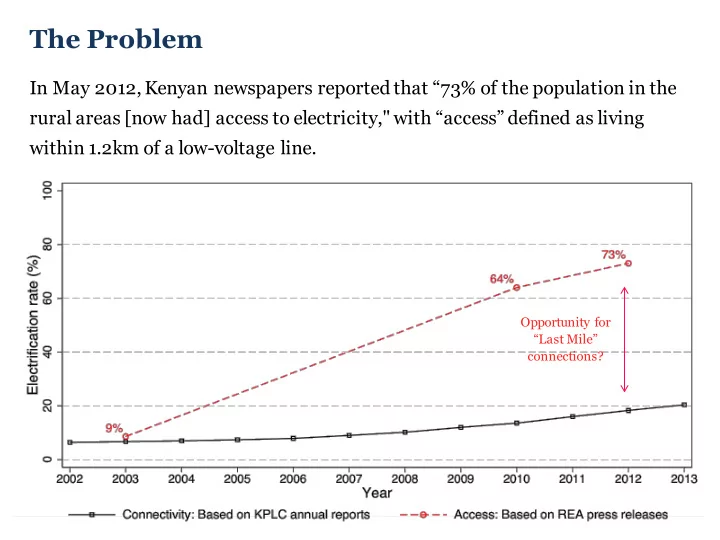

The Problem In May 2012, Kenyan newspapers reported that “73% of the population in the rural areas [now had] access to electricity," with “access” defined as living within 1.2km of a low-voltage line. Opportunity for “Last Mile” connections?
Field experiment In September 2013, we partnered with Kenya’s Rural Electrification Authority (REA) to identify a sample of 150 rural “transformer communities” in Western Kenya. We followed a selection procedure to ensure that our sample is representative of “under grid” communities in rural Busia and Siaya counties. Rural Electrification 2
Example of a “transformer community” Legend T Transformer & 600 meter radius Households (scaled by household size) Businesses Public facilities (e.g. schools, health) Electrified households Electrified businesses Electrified public facilities Rural Electrification 3
Rural Electrification 4
Despite large investments in the rural grid, electrification rates remain low.
Half of the unconnected households in the study are “under grid.”
Experimental design Census sample 150 “transformer communities” in Western Kenya in partnership with REA Geo-tagged universe of 12,001 unconnected HHs within 600 meters of a transformer Study sample Randomly sampled 2,289 unconnected and 215 connected households across all 150 communities for main sample High subsidy Medium subsidy Low subsidy Control group Price: $0 Price: $171 Price: $284 Price: $398 25 communities 25 communities 25 communities 75 communities 380 unconnected 379 unconnected 380 unconnected 1150 unconnected households households households households Rural Electrification 7
Key Finding 1 1. What is the demand for grid connections? Rural Electrification 8
Willingness to pay for electricity connections Q1. Would you be willing to pay [AMOUNT] KSh for an electricity connection?
Willingness to pay for electricity connections (cont’d) Q2. Imagine that you were offered an electricity connection at this price today, and you were given 6 weeks to complete the payment. Would you accept the offer?
What is the take up rate at Ksh 15,000? A. 10% B. 20% C. 30% D. 40% E. 50% Rural Electrification 11/36
What is the take up rate at Ksh 25,000? A. 10% B. 20% C. 30% D. 40% E. 50% Rural Electrification 12/36
Stated willingness to pay results Rural Electrification 13
Key Findings (cont’d) 1. What is the demand for grid connections? Demand declines rapidly with price and is lower than expected by policymakers (or us). 2. Are there economies of scale in mass connections? Rural Electrification 14
Rural Electrification 15
Rural Electrification 16
The above figures plot budgeted estimates of the average total cost (ATC) per connection per various levels of community coverage (i.e., electrification) for both sample and design communities. Rural Electrification 17
Results (cont’d) 1. What is the demand for grid connections? Demand declines rapidly with price and is lower than expected by policymakers (or us). 2. Are there economies of scale in mass connections? Using actual electrical utility cost data, strong evidence for declining average costs in the range of coverage in the sample (0-40%), up to 100% coverage in communities with designs. 3. What are the welfare implications of a mass household electrification program? Rural Electrification 18
Rural Electrification 19
Free mass electrification case à Total Cost 4.5x Consumer Surplus à Need welfare gains of $511 per household Rural Electrification 20
Results (cont’d) 1. What is the demand for grid connections? Demand declines rapidly with price and is lower than expected by policymakers (or us). 2. Are there economies of scale in mass connections? Using actual electrical utility cost data, strong evidence for declining average costs in the range of coverage in the sample (0-40%), up to 100% coverage in communities with designs. 3. What are the implications of a mass household electrification program? The price that a consumer is willing to pay for an electricity connection if far less than the actual cost of connecting that consumer. Rural Electrification 21
Comprehensive socio-economic impacts of electrification Outcomes of interest: A. Children’s education G. Household roster B. Health H. Land and agriculture C. Political awareness I. Energy D. Social cohesion J. Markets E. Household assets K. Time use F. Employment
Thank you fmeyo@poverty-action.org & esmith@poverty-action.org Rural Electrification 23
Recommend
More recommend